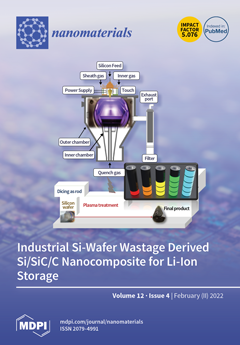Tungsten oxide (WO
3), MXene, and an WO
3/MXene nanocomposite were synthesized to study their photocatalytic and biological applications. Tungsten oxide was synthesized by an easy and cost-effective hydrothermal method, and its composite with MXene was prepared through the sonication method. The synthesized tungsten oxide, MXene, and its composite were characterized by X-ray diffraction (XRD), field emission scanning electron microscopy (FESEM), Fourier transform infrared (FTIR), energy-dispersive X-ray analysis (EDX), and Brunauer–Emmett–Teller (BET) for their structural, morphological, spectral, elemental and surface area analysis, respectively. The crystallite size of WO
3 calculated from XRD was ~10 nm, the particle size of WO
3 was 130 nm, and the average thickness of MXene layers was 175 nm, which was calculated from FESEM. The photocatalytic activity of as-synthesized samples was carried out for the degradation of methylene blue under solar radiation, MXene, the WO
3/MXene composite, and WO
3 exhibited 54%, 89%, and 99% photocatalytic degradation, respectively. WO
3 showed maximal degradation ability; by adding WO
3 to MXene, the degradation ability of MXene was enhanced. Studies on antibacterial activity demonstrated that these samples are good antibacterial agents against positive strains, and their antibacterial activity against negative strains depends upon their concentration. Against positive strains, the WO
3/MXene composite’s inhibition zone was at 7 mm, while it became 9 mm upon increasing the concentration. This study proves that WO
3, MXene, and the WO
3/MXene nanocomposite could be used in biological and environmental applications.
Full article






